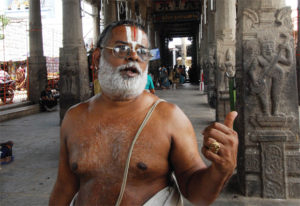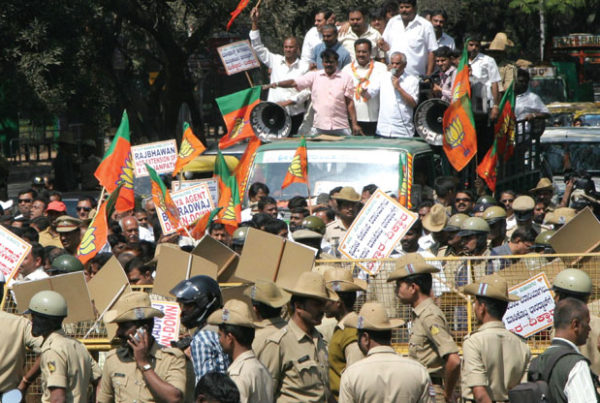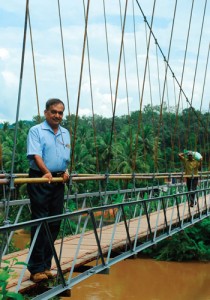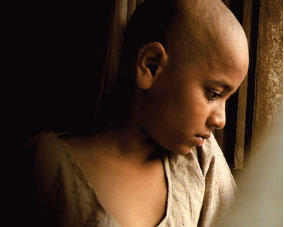Tamil Nadu’s radical attempt to train dalit priests has been hijacked by prejudice. Sanjana Chappalli tracks the differing impact on the lives of the young novices
 Just say no: VA Kannan, Chief priest,Sri Parthasarathy Swami temple Chennai is opposed to the government order. Photos: S Radhakrishna
Just say no: VA Kannan, Chief priest,Sri Parthasarathy Swami temple Chennai is opposed to the government order. Photos: S RadhakrishnaBRAHMINS WERE created by God to serve them. How can we (non-Brahmins) ever say or do anything that questions that?” Twenty-four-year-old Saravanan Subramanian displays a ready subservience to the highest Hindu caste. Ironically, however, Saravanan is part of a radical social transformation programme that is designed to break one of the last remaining Brahmin bastions – a monopoly over priesthood.
In a pioneering move by the government of Tamil Nadu, a May 2006 government order declared that “suitably trained and qualified Hindus, without discrimination of caste, creed, custom or usage” were to be appointed as archakas (priests) to any of the 36,000 temples under government administration across the state. These temples include the revered Meenakshi temple in Madurai, the Murugan temple in Palani, the Parthasarathy Swamy temple in Chennai and the Ranganathaswamy temple in Srirangam. For generations, these Shaivite and the Vaishnavite temples have been exclusive Brahmin bastions and have followed the hereditary principle of succession when it comes to the appointment of priests. This bold order made it possible for dalits to officiate in these prestigious temples.
In 1970, an amendment to the Tamil Nadu Hindu Religious and Charitable Endowments Act abolished the hereditary appointment of temple archakas, stating, “No person shall be entitled to appointment to any vacancy… merely on the grounds that he is next in the line of succession to the last holder of office.” The 2006 order extended the order passed 30 years earlier. In May 2007, the Tamil Nadu government set up six archaka training centres across the state, which offered a year-long certificate course in agama sastras (priesthood studies).
The centres were attached to major Shaivite and Vaishnavite shrines such as the Parthasarathy Swamy temple and were governed by the state’s Hindu Religious and Charitable Endowments (HR&CE) Department.
BRAHMIN PRIESTS AT THE MADURAI MEENAKSHI TEMPLE HAVE CHALLENGED THE ORDER
Advertisements inviting applications to the free year-long course at one of the six centres were published across the state, promising students a monthly stipend of Rs 500 and a job at a government- administered temple when they finished the course.
Chief Minister M Karunanidhi claimed that the order fulfilled Dravidian leader Periyar’s desire to remove caste barriers. The promise of a job and the offer of a monthly stipend for students had the desired effect. Out of a maximum intake of 240, 207 students passed their examinations. Only three of the 207 were Brahmins. TEHELKA spoke to Arun Kumar (see box), who was the only Brahmin in his batch of 36 – and the only one among them to get a job as a priest. He revealed that while he had remained aloof and guarded in the beginning, he gradually became friends with his backward caste and dalit coursemates.
Unfortunately, despite long historical precedence, the government’s attempt to bring to fruition Periyar’s struggle against caste discrimination in temples has met with its share of social and legal obstacles. On the legal front, several petitioners, including the Adi Saiva Sivacharyargal Sangam — a group of hereditary priests at the Madurai Meenakshi temple — have challenged the order in the Supreme Court. They claim that the order appointing archakas to government-run temples irrespective of their caste violated Articles 25 and 26 of the Constitution, which grant the right to freedom of religion. A stay on the appointments has been granted and hearings are on.
SOURCES IN the HR&CE department say that long-running legal battles weigh down the government. “We expected some sections — primarily those affected by the order — to rise up in revolt. But there are earlier Supreme Court judgments on the matter: in 2002, the Supreme Court upheld a Kerala High Court judgement that Hindus, regardless of their caste, could be appointed as priests. And even earlier, in 1972 there was a judgement with specific reference to Tamil Nadu. Despite all this, we have a battle on our hands,” said an official.
Even as the government fights the legal battle, it has been forced to disband the centres and suspend the training course. Even the students who have completed the courses have not been given certificates of completion, let alone their appointment orders. Without this criticial step, almost all of these 207 students are facing social rejection as priests. Jobs at temples are scarce since apart from three of them, these archakas are not Brahmins. Offers to officiate at local religious ceremonies are few and far between and the students are forced to fend for themselves.
THE GOVERNMENT HAS BEEN FORCED TO DISBAND THE INSTITUTES AND SUSPEND THE COURSE
In an attempt to understand the relevance and impact of the Tamil Nadu government’s intervention, TEHELKA tracked down several youths who had completed their training in June 2008. Their stories speak of the significance of this step in a land deeply scarred with caste bias.
Economic stability and social mobility remain primary motivators despite the different ways that caste and class affect their lives.
—
This article was originally published in Tehelka, a leading independent news magazine in India, known for its investigative journalism.



